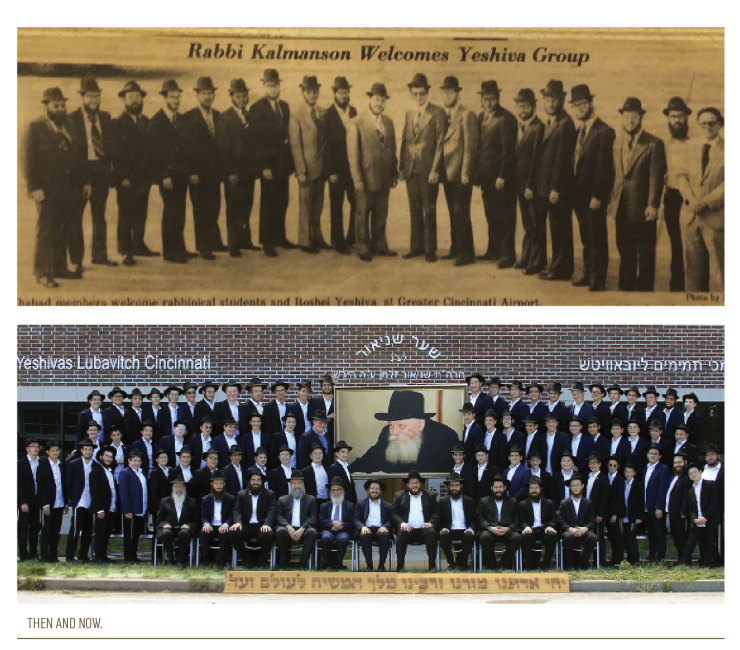The Tzemach Tzedek’s Grandson Who Shuttered Cincinnati’s Reform “Hebrew Union College”
On Yud-Alef Nissan 2022, the Cincinnati Enquirer reported “147-year residential rabbinical program closes in Cincinnati.” To understand why the closing of the program is an open miracle and a reason for an article in this publication, Beis Moshiach Magazine spoke to Rabbi Sholom Dovber Kalmanson, a leader in the war against the Reform movement and heard rare statements from the Rebbe on the issue • Full Article
By Shneur Zalman Newman, Beis Moshiach Magazine
On Yud-Alef Nissan 2022, the Cincinnati Enquirer reported under the heading “147-year residential rabbinical program closes in Cincinnati,” that “Cincinnati’s Hebrew Union College campus in Cincinnati’s University Heights neighborhood will stop ordaining [Reform] rabbis.”
The closing of the program didn’t come in a vacuum. The Pew Research Center reported that Reform and Conservative congregations in the United States are dwindling. Over recent years, about a quarter of these congregations have closed. Over the same two decades, Chabad grew 300% and close to 40% of American Jews participate to some degree or another in Chabad programming.
“It’s an astonishing miracle of the Rebbe, and Lubavitchers are not aware of it. If we grasped what occurred on Yud-Alef Nissan 2022, we would go out to dance in the streets,” says Rabbi Gershon Avtzon, rosh yeshiva of Tomchei Tmimim Lubavitch in Cincinnati. “The closing of the program symbolizes a victory of our Rebbeim over the Reform movement. More precisely, the Rebbe’s war, which ended in a resounding victory.”
To understand why the closing of the program is an open miracle and a reason for an article in this publication, we spoke to the Rebbe’s shliach in Cincinnati, Rabbi Sholom Dovber Kalmanson, who was a leading player in the war against the Reform movement and heard rare statements from the Rebbe on the issue.
COMING FULL CIRCLE
R’ Kalmanson:
“In the summer of 5734 I had yechidus with the Rebbe. I gave the Rebbe a note which said that my wife and I wanted to go on shlichus and there was a list of places that I had been offered.
“In the early years of the shlichus revolution, the Rebbe himself would say where to go. However, after several instances in which the families of the shluchim complained about their children being sent to ‘far-out holes in the wall’ materially and spiritually, the Rebbe changed the system. Whoever wanted to go on shlichus had to look for a suitable place and when several suggestions were written down, the Rebbe would choose from the list which had already been agreed upon by the couple.
“I thought the Rebbe would choose one of the places on my list. He took the paper and read through it quickly. I stood there tensely, waiting to hear which place the Rebbe would choose. How surprised I was to hear the Rebbe ask, ‘Why not Cincinnati?’
“I had never heard of this city and didn’t know where it was located but since the Rebbe asked, I immediately said if the Rebbe wants me to go to Cincinnati, I’d be there the next morning, b’ezras Hashem (which is what happened).
“Then I asked the Rebbe, since he chose Cincinnati, were there any special instructions or anything I needed to know?
“The Rebbe said, ‘It is known that when the Tzemach Tzedek got rid of Lilienthal [a German and one of the prominent Maskilim, appointed by the Russian government (of Czar Nicholas I) as the Minister of Jewish Education, who attempted to destroy Yiddishkeit and was vanquished at a conference on education with Rabbi Yitzchok of Volozhin and the Tzemach Tzedek] he left for the United States, to Cincinnati, where he established the Reform movement. The descendant of the Tzemach Tzedek will finish off with the descendants of Lilienthal.’
“When I left the yechidus I realized I had been assigned a particularly challenging shlichus in which I would have to contend with the strongest forces of kelipa, but since I was the Rebbe’s representative, we would surely win.”



Rabbi Kalmanson giving the Rebbe the key to the Chabad House in Cincinnati. In the background is the Reform Hebrew Union College whose rabbinical program closed after 147 years.
THE GRANDSON OF ‘SHIMON THE HERETIC’
Who was the Lilienthal that the Tzemach Tzedek fought? To answer this question, we need to go back in history to the time of the Alter Rebbe and his war with the Haskala movement which is described at length in “Reshimas Shimon HaKofer.” Shimon Lilienthal, known as ‘Shimon the Kofer’, was an undercover maskil who was sent to Vilna to woo Jewish youth to the haskala movement.
After succeeding among the Misnagdim, he tried to penetrate the Chassidic community and even had yechidus with the Alter Rebbe in Liozna. That is when he was exposed for who he was and after the Alter Rebbe informed the askanim in Vilna about the heretic’s true intentions, they investigated. In the end, his disgrace was exposed in public and he was thrown out of the city in shame.
Two generations passed and once again, the two sides were at war over the character of the Jewish nation. On the side of holiness stood the Tzemach Tzedek, grandson of the Alter Rebbe, and on the side of kelipa stood the grandson of Shimon the Kofer, Menachem (Max) Lilienthal. What Shimon the Kofer tried to accomplish with sweet talk, his grandson tried to do with force as he enlisted the Russian government and tried to force Jewish communities to teach haskala to pure Jewish children.
In the kuntrus, “Admor ha’Tzemach Tzedek u’Tenuas ha’Haskala,” the Rebbe Rayatz writes about him, “Lilienthal, born in Munich, Bavaria [was the son of Binyomin the son of Shimon the Maskil] was educated in an environment of those who abandoned Jewish religion, the assimilation cult. He graduated high school in Munich and became friendly with the children of the nobles of the country.”
Like his grandfather, he had no qualms about going to Lubavitch and having yechidus with the Tzemach Tzedek for the purpose of convincing him to come to a special meeting of the Minister of Education and some gedolei Yisrael to force them to agree to open houses of ‘haskala’ for Jewish youth.
After meeting with the Tzemach Tzedek, Lilienthal wrote to the Russian government that “the most important rabbi among Russian Jewry is R’ Mendel of Lubavitch because the Chassidim in Vitebsk, Mohilov, Chernigov, Kiev, Cherson and Minsk raise him above them as their leader. His consent to the government’s wishes would be for the Chassidim an inviolable decree.”
The Russian minister accepted Lilienthal’s suggestions and sent an order to Lubavitch which said the Tzemach Tzedek was appointed a member of the committee and he had to appear in Petersburg. The conference took place in the summer of 5603/1843, in the course of which the maskilim’s representative worked hard to push a new curriculum which clashed with our mesorah. The Tzemach Tzedek insisted that no changes would be made in the Jewish curriculum.
The Tzemach Tzedek was arrested 22 times during the course of the conference because he did not fear to express his view forthrightly. Each time, he was arrested for several days and then released and the discussions continued. After much effort, the government accepted his position and the decree was abolished.
THE SPIRITUAL WAR AGAINST LILIENTHAL
In a sicha of the Rebbe Rayatz, he says that before Rosh Hashana 5603, they saw a change in the Tzemach Tzedek’s conduct and they did not understand the reason for the drastic changes. The Rebbe Rayatz revealed, “The real reason for the change in conduct was that the Alter Rebbe informed the Tzemach Tzedek that the coming year, 5603, would be a difficult year for him. And so it was. That year, the Rebbe went to Petersburg for the rabbinic convention where he suffered greatly from the maskil and kofer, Menachem Lilienthal, grandson of the kofer and maskil Shimon of Zamut.”
Erev Rosh Hashana 5603, they saw a change from other years. Every year, on erev Rosh Hashana, after hataras I, a Beis Din of ten would bless the Rebbe with long life – erev Rosh Hashana is his birthday – and the Rebbe would answer, “amen, ko yomar Hashem,” or “amen, kein yehi ratzon.” That year, he said, “amen, kein yehi ratzon” and added, “the fifty-fourth year of a person’s life is a most difficult year and one needs a doubled and tripled bracha.”
On erev Rosh Hashana 5603 and on Tzom Gedalya, his mother’s yahrtzeit, the Rebbe sent his gabbai, the Chassid, R’ Chaim Dovber, with a pidyon to Liozna to his mother’s grave. Both pidyonos had the same wording, “The people from Berlin are becoming powerful, the decree is ready to be made public, their counsel is to invite rabbanim to agree to their suggestions. Either way, whether I live or… please go to the chamber of your father and deliver to him my request to arouse mercies that the decrees be annulled, and if I merit, may it be the will that they are annulled through me.”
Despite his defeat at the conference, Lilienthal continued to look for other channels where he could change Jewish education and shape the “new Jew.” In 5605, he went to visit his family in Germany and surprisingly did not return to Russia. Instead, he emigrated to the United States. His colleagues in the haskala movement were stunned by his leaving and until today, historians are divided over what motivated him to leave.
Nearly a hundred years later, on Rosh Hashana 5704, the Rebbe Rayatz revealed what happened behind the scenes. “The Rebbe the Tzemach Tzedek made the famous activist, the maskil Lilienthal, flee the country, Russia, through his tefilla and talk on a certain Rosh Hashana.
“Lilienthal was close to the royal court and that Rosh Hashana he was going to travel to carry out the decree to force Jewish children to learn in ‘chadarim’ according to their curriculum. They informed on him that he stole money. The truth is that someone else stole it, it was not something that he would do, and because of this he had to smuggle across the border and he fled to America. He arrived in Cincinnati and founded a Reform seminary there.”
Lilienthal first arrived in New York where he became the rabbi of a German community. Ten years later, in 5614, he moved to Cincinnati and became the leader of the Reform community. There (along with his friend, the heretic Isaac Wise) he was one of the founders and leaders of Hebrew Union College, with its seminary for Reform rabbis. Most leaders of Reform congregations around the world were trained in this institution.
In the Rebbe Rayatz’s Igros Kodesh he expresses himself sharply against the work of Lilienthal in destroying Judaism in the United States:
“However, it is known the history of the powerful disciples of Nimrod in America since the arrival of the inciter and instigator, Lilienthal, especially in the past twenty years when the senior heretics have set up their students as teachers in schools, some of whom penetrated the Talmud Torahs and chadarim and poisoned the minds of children with the poison of heresy in G-d and His Torah, and mocking the mitzvos of Hashem, and scorning Jewish tradition. Their entire goal was to make the Jewish Nation repugnant in the eyes of the youth in order to achieve their cursed goal of uprooting the pintele Yid from their hearts with all sorts of treachery.”
PERSONAL FRIENDSHIPS ALONG WITH SPIRITUAL WAR
R’ Kalmanson:
“As mentioned, after I left the yechidus, I realized this would be a war against the forces of kelipa which Lilienthal established in Cincinnati, especially Hebrew Union College which was the source of impurity of all the misleading leaders (the Rebbe used the term ‘misleading’ in his farbrengens, saying that these leaders misled their flocks).
“The war was mainly spiritual and not against members of the Reform community. Personally, I formed friendships with leading figures in Hebrew Union College, as a result of which they allowed me to enter what they called the ‘Rare Book and Manuscript Collection.’ This is a hidden section within their general library which is huge and contains over a million printed volumes and is the second largest in the Jewish world (after the National Library of Israel).
“How did all these treasures get there? Members of Reform communities were descendants of G-d fearing Jews. When Grandpa died, the grandchildren were not interested in his books. They sent them to the library and that is how, over the years, books accumulated from all across America. Also, many sefarim were brought from Europe after the Holocaust.
“The Rare Book and Manuscript Collection is not available to the public. Because of my friendship with senior people in the library, I was able to see it. One day, I found manuscripts that looked to me like they were from one of the Rebbeim. I called the secretary, Rabbi Leibel Groner and asked whether the Rebbe has these manuscripts. He didn’t know and he referred me to Rabbi Aharon Chitrik who dealt with the manuscripts in the Rebbe’s library. I called him and found out that they were manuscripts from the Rebbe Maharash and Rebbe Rashab that were not in the Rebbe’s library.
“After much effort, we were able to send the manuscripts to where they belonged, the Rebbe’s library. When maamarim were printed from these manuscripts, it was noted where they came from.
“That is one episode that occurred because of my personal friendship with some leaders in Reform, obviously, without any public identification with them.
“I asked the Rebbe about everything and the Rebbe did not always approve collaborating with them, even when it seemed it would enable achieving positive results regarding matters that concerned the Rebbe. For example, during the years of the Rebbe’s great war to amend the Law of Return (Mihu Yehudi), I wanted to enlist their president Dr. Gottschalk to come out together with me in favor of amending the law. When he asked permission of the leader of his movement, he agreed on condition that my signature appear on the same statement. I wrote to the Rebbe and the Rebbe said no, because it would look as though Lubavitch is partnering with the Reform movement. Despite his war to amend the law and the achievement this would be, the Rebbe still did not allow it to appear that we approved of them.”



THE YESHIVA
The spiritual war was basically carried out through the shlichus activities of R’ Kalmanson in the city; the mivtzaim, spreading the wellsprings, and being mekarev Jews to the great light of the Rebbe. However, a very significant part of this war was accomplished by the yeshiva.
In the Dvar Malchus of Vayeishev 5752, the Rebbe points to the transformation wrought in France in our generation, emphasizing the birur of the place accomplished by the yeshiva Tomchei Tmimim which was founded there.
There is a yeshivas Tomchei Tmimim in Cincinnati too, and when we recall the fact that the Rebbe Rashab said on more than one occasion that the role of Tomchei Tmimim is to fight against those who spread the teachings of ‘enlightenment,’ this takes on greater meaning in Cincinnati.
In its previous incarnation, the yeshiva opened through an ‘arousal from above’ by way of a direct instruction from the Rebbe. Rabbi Kalmanson relates:
“It was 5736, ten days before Lag B’Omer when I got a phone call from Rabbi Chodakov. He said the Rebbe wants me to open a yeshiva in Cincinnati that should begin operating in a an organized way by Lag B’Omer!
“That was quite a surprise, especially when the zman was almost over. Whoever I told about this instruction could not understand how a yeshiva could be started on such short notice without logistical support and without funding. But since this is what the Rebbe requested, we did it. The yeshiva opened with talmidim sent from 770.
“A few days later, I was called again and told that the Rebbe wanted me to contact Rashag and ask him to call the Litvishe rosh yeshiva in Baltimore, Rabbi Ruderman, who was not a fan of Chabad, and ask him not to open a branch of his yeshiva in Cincinnati.
“Apparently, the Rebbe knew about his plan to open a branch in Cincinnati, which would not contribute toward the Ahavas Yisrael in the Jewish community there. The Rebbe preempted him by saying Tomchei Tmimim should open.
“I called Rashag who was a member of the board of yeshivas in the US and had a lot of influence there. The next day, he called me back and told me to tell the Rebbe he had taken care of it.
“The yeshiva operated for two years until some problems came up that I won’t go into. It seems the sitra achra was bothered by the fact that a yeshiva existed in Cincinnati and against our will we had to close it. The Rebbe accompanied us all the way with many wondrous answers during that time and I understood that the decree was sealed. Without getting into the details that led to the closing of the yeshiva, the final answer we got from the Rebbe about the yeshiva was, ‘You will receive reward specifically from pulling back.’
“Today, I know that the greatest reward is the reopening of the yeshiva by Rabbi Gershon Avtzon.”
OPENING THE NEW YESHIVA AND THE BEGINNING OF THE END OF REFORM
Seventeen years ago, Rabbi Kalmanson was speaking all over Eretz Yisrael and he visited several Chabad yeshivos. He was especially impressed by the yeshiva gedola in Tzfas and by their chayus in inyanei Moshiach. He longed to open a yeshiva in Cincinnati that would educate based on those ideals.
At just that time, Rabbi Gershon Avtzon, a young married man, was thinking of going on shlichus. “I had some offers which I checked out, but when I wrote to the Rebbe, the answer in the Igros Kodesh changed all my plans.
“In the answer, the Rebbe wrote: You have experienced success in your work in chinuch, especially with youth. Why aren’t you continuing in this vein?
“I decided that I would put my desires aside and devote myself to chinuch in which I had been successful before I married. I looked for an existing framework which I could join but when I spoke with my mashpia and other rabbanim, we came to the conclusion that in order to carry out the chinuch approach I believed in, I had to open something new.”
By divine providence, his friend, Rabbi Gavriel Levin, heard about this and told him that his father-in-law, R’ Kalmanson, wanted to open a yeshiva in Cincinnati.
“That same day, I called R’ Kalmanson and he decided to work towards the opening of the yeshiva. Things moved very quickly and became a joint project. R’ Kalmanson still had the building that served the talmidim of the yeshiva in 5737. He committed to renovating it as well as paying the maintenance expenses that came with using the building while I committed to bring talmidim and take care of salaries for the staff.
“At first, we thought of opening just shiur alef but when we wrote to the Rebbe we opened to an answer that left no room for doubt. The Rebbe wrote to someone in chinuch that he should work with doubled energy and then he will reveal strengths in himself that he didn’t know about.
“We decided to open the yeshiva with two shiurim. As with every matter of holiness, there were plenty of difficulties but with siyata d’shmaya and a lot of the Rebbe’s kochos we overcame them. Today, we see the fruits of our labor, bachurim living with Moshiach, living with mivtzaim and the Rebbe’s horaos in a pnimiyusdike way. We feel that the Rebbe continues to accompany the yeshiva both spiritually and materially.
“Our idea of starting a yeshiva was one in which the bachurim would live with Moshiach with the utmost simplicity, that it be clear that this is something we live with and is not something to debate. This is why we chose Cincinnati where the Chabad community, without exception, lives with Moshiach. Every day in yeshiva we have a shiur in inyanei Geula and Moshiach. When the talmidim see the hanhala living with Moshiach, the shluchim living with Moshiach, it penetrates. It creates a situation in which I don’t have to work to get them excited about about inyanei Moshiach. They live with the holy proclamation of Yechi.”



***
In hindsight, R’ Kalmanson and R’ Avtzon think that one of the reasons for the renewed opening of the yeshiva in Cincinnati was an essential stage in the spiritual war against Reform. It’s a fact that in research done on the reasons for closing the Reform rabbinical program, those who conducted the research cited the era in which the yeshiva was restarted, seventeen years ago as the point in time when the institution began to go under. From that year and on there was a precipitous drop in the number of students which led to the closing of the program.
“One cannot know what a tamim can accomplish,” says R’ Avtzon. “Sometimes, he can think, ‘What difference does it make what I do?’ but by his learning and behaving as a tamim, as the Rebbe wishes, there is an enormous spiritual impact even if we don’t see it immediately.”
THE REBBE’S VICTORY ON HIS BIRTHDAY
“One of Moshiach’s roles is ‘to fight the wars of Hashem and win.’ Even if it takes time, in the end, he will win. If I would have said when I arrived here on shlichus that one day, the Hebrew Union College rabbinical program would close, everyone would have laughed at me. It was a such an established institution that one would never consider it could run into difficulties. Even the goyim here were proud of this age-old institution which existed for close to 150 years!
“Some years ago, it seemed the Reform institution was on the verge of bankruptcy. We thought that the end was nigh but then a wealthy American organization came in and rescued them. I was disappointed but in the end, last year, on Yud-Alef Nissan, they held a vote and decided to close the rabbinical program. Hebrew Union College in Cincinnati no longer exists.
“The Rebbe said he wants to finish the war with the descendants of Lilienthal and it happened. When? On the Rebbe’s birthday!
“When the Rebbe says something, it will happen, not 99%, but 100%. If that is true for something said in a private yechidus, all the more so for the Rebbe’s prophecy of Geula which the Rebbe said to publicize. Certainly it will happen.”
*
The magazine can be obtained in stores around Crown Heights. To purchase a subscription, please go to: bmoshiach.org
486
Join ChabadInfo's News Roundup and alerts for the HOTTEST Chabad news and updates!
















































Nice story but don’t get so excited. The rabbinical program in Cincinnati is only closing down because there are bigger Reform rabbinical training programs in NY and LA which are attracting all of the students.